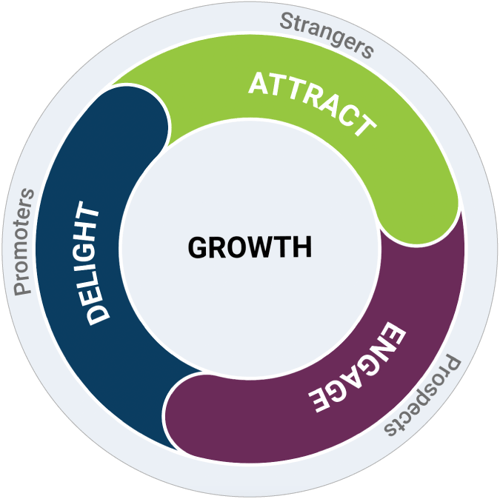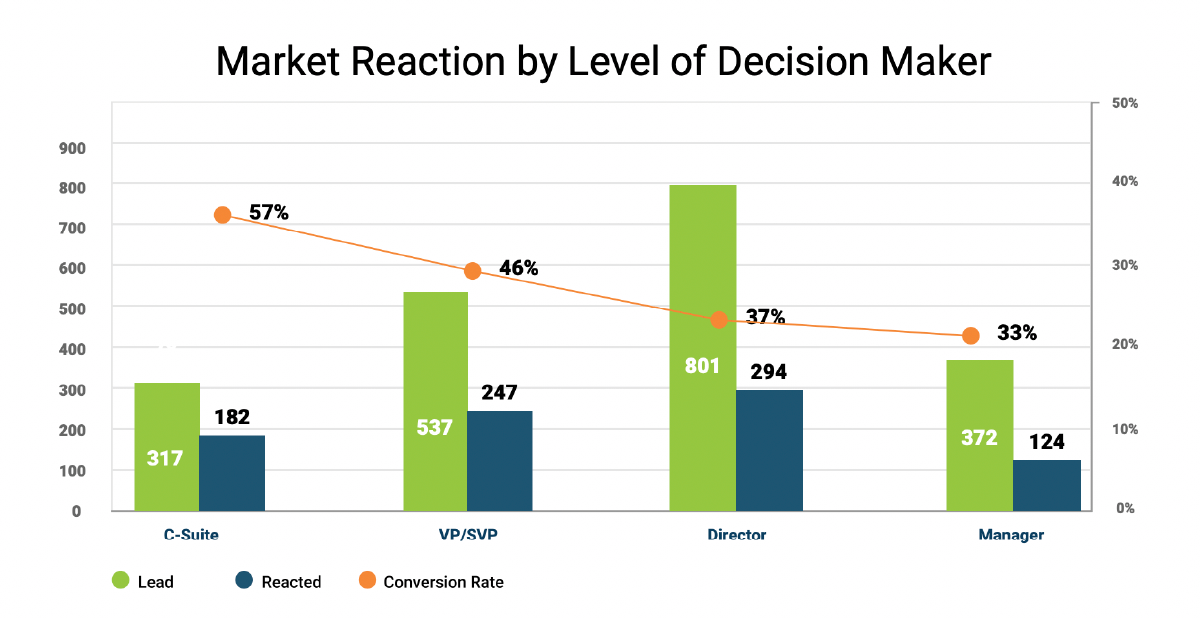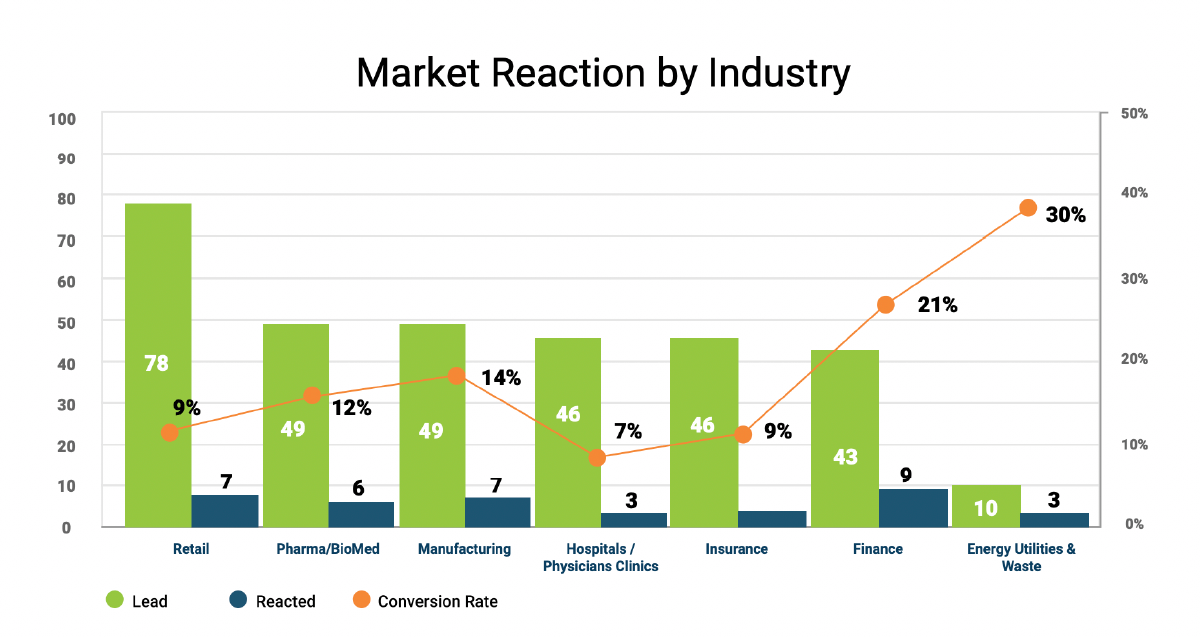An Account Based Selling (ABS) methodology brings marketing and sales together to pursue high-value accounts with a personalized approach that closely ties the company’s value proposition to the prospect’s needs.
At MarketLauncher, we have been helping clients enable the sales side of an Account Based approach for over two decades. In this document, we share the insights we have gathered through our extensive use of ABS in four key areas that are especially critical.
- Know your Audience
Ensure your sales team is focused on engaging the right individuals at accounts that meet your ideal client profile. These are the accounts with the highest revenue potential. - Build Trust
In an enterprise sale, trust plays a key role in the buying decision. Whether pursuing net new logos where you have no prior relationship or maintaining existing relationships, it is critical that you communicate highly relevant information early in the sales process. This will help build trust with new prospects and maintain trust with existing contacts. - Nurture Past, Present & Future Clients
Maintain a systematic outreach plan for ALL clients. This allows you to educate buyers and keep your offering top of mind. This is your best opportunity to expand revenue and create advocates and FANS which are what make your flywheel spin! - Manage your Data
Quantitative metrics and qualitative intel will surface trends that can validate your efforts or signal that a change is required. The best sales and marketing programs are the ones that pivot and evolve with the changing needs of the market.
Know Your Audience
Invest the time to establish your Ideal Client Profile (ICP). But keep it simple!
Review your existing client base and look for commonalities across industry, company size, region and any other specific criteria that may trigger a need for your offering. Also look at your primary points of contact in each client account.
- Were they the decision maker or a key influencer in the buying process?
- Who are the other stakeholders who may have owned the original pain?
Try to hone in on the right functional areas of responsibility and decision-making levels of authority to create a list of the roles and titles that are most likely to be involved at various stages of the buying process.
This is key because we often see clients make the mistake of focusing too much attention on only one primary role as the perceived buyer. For example, there are many situations where the CFO may be the ultimate decision-maker. But often the buying process is triggered by someone else in a position to know there is pain and has the authority to pursue solutions. In those cases, we always recommend pursuing both the CFO and the other roles more closely aligned with need for a solution. This allows you to gain the right point of entry to begin the sales process, while also creating awareness at the top where the ultimate decision will be made.
I’ve got my ICP. Now what?
Now that you have an ICP, we recommend leveraging market research tools like ZoomInfo, to build a list of target accounts and key contacts.
By using the same criteria you used to establish your ICP, tools like ZoomInfo - powered by DiscoverOrg, Lead411, and Definitive Healthcare allow you to quickly and easily build a robust list of target accounts.

“Having the right list of resources in place is so important to support an ABS strategy. It truly is the key to strategically arming your team with the best starting point to get to the right decision maker, gather intel and help understand buying decisions within a company.”
Mary White Chief Operating Officer
We cannot stress this enough: once you have built a list, that is not where the process stops. If you download a list and start blasting out emails you are going to be disappointed in the results. You may even (incorrectly) assume that the list was bad, or that email is ineffective at reaching your potential buyers. But in reality, it is just that you missed a critical step.
When starting an Account Based Selling program it is critical that you do phone outreach to verify the contacts on your list and warm them up to receive email.
That initial phone outreach allows you to discard bad data (any list you download from any source is going to be at a minimum 80% viable). You will also have a chance to add new contacts as you reach some decision-makers and are referred on to someone else in the organization who is a more direct point of entry. Working from a clean and verified list dramatically increases the effectiveness of your program and lets you further hone your message based on what you learned just from that initial touch point.
Once you are certain your list is populated with the right contacts, your analysis on the results you are getting will be far more actionable. (For more on what we mean by that, revisit our previous blog on Why Email Marketing is Kinda Like Football.)
We also recommend you do a refresh on your list every six months.
This includes downloading any updated information from your primary list source, as well as doing another round of outbound calls to capture any adds, changes or deletes based on personnel movements or even changing stakeholders involved in key initiatives.
Build Trust Through Account Based Selling
Trust has always been an important part of the buying cycle. At ML, we see the benefits of building trust early in the sales and marketing effort. And the value doesn’t end when you sign a new account. When done correctly, building trust will result not only in new clients, but in advocates who will help you grow revenue.
Applying an ABS methodology to your selling efforts creates trust
More than 60% of ML’s current active programs are made up of long-term clients, returning clients and people we have worked with at multiple companies. That loyalty comes from two decades of building trust. One way to build trust is to make sure you are engaging with the right people. Nothing kills trust faster than wasting someone’s time. When you are sharing relevant content aimed at someone who is in a position to gain value from the information, you are in the early stages of building trust with a prospect.
We are a marketing software company, so you can’t just throw anybodyon the phone and have them deliver our value proposition without beingable to talk the talk. The Marketlauncher team got up to speed quicklyand showed they could not only engage with our customers but alsoscale that effort for growth.
SVP SalesPricing Optimization Software
Engagement that builds trust
At ML, we employ many techniques to engage target accounts with a regular cadence of effective messaging. This cannot be a “one and done” outreach effort.
Your engagement plan must involve multitouch points that deliver messaging focused on the business needs and pain points of your target market, providing insights and information of value that educate your potential buyers.
This kind of outreach warms prospects up so that they will respond to your personalized emails and phone calls. Even if your audience doesn’t immediately respond, demonstrating value with content that shows knowledge about their industry, their role, and their challenges creates a One-Way Dialogue that will build trust.
We have seen this in our own new business efforts. I can name a handful of ML clients who reached out to us asking for a proposal after months of no response to our outreach efforts. In a few particularly rewarding cases, that one-way dialogue had been going on for anywhere from one to ten years, keeping us top of mind with our contacts.
If you haven’t already, invest in the best tools that facilitate digital engagement. This includes CRM and automation platforms like HubSpot, but also video conferencing technology
Many analyst firms and sales organizations are reporting that using digital technologies for selling will not go away post-COVID.
McKinsey reports that remote-based selling has been embraced by buyers saying: "Around 90% of B2B decision makers expect the remote and digital model to stick around for the long run, and 3 in 4 believe the new model is as effective or more so than before COVID-19 (for both existing customers and prospects)."
ML has functioned in a virtual environment since our inception in 2001. We’ve benefited greatly from the evolution of technologies that make it easier to connect. When the pandemic began, one of our first priorities was to share our expertise to help our clients maximize the benefits of remote operations and adjust their sales approach, leveraging tools like Zoho Connect and Zoom Video Conferencing which we’d already been using for years.
Nurture Past, Present & Future Clients
One thing the team at ML witnesses regularly is a tendency for companies to neglect mining their existing client base for new revenue opportunities, and not being proactive enough in maintaining contact with former clients or lost opportunities.
At ML, we coach our clients to be systematic in their outreach to clients, former clients and lost prospects. We have learned (from our own success as well as applying this approach for our clients) that you can dramatically increase revenue by capitalizing on opportunities you didn’t realize exist within current and previous clients and prospects.
In the previous pages, we explained:
- How an ABS methodology removes friction from the selling process to build trust and win new clients.
- The Importance of Ideal Client Profiles and promoting your value proposition to the right people in the right accounts.
- How to maintain a one-way dialogue with relevant, personalized messaging to engage prospects, and how a skilled team aligned with the right tools can help turn prospects into clients.
But what about your existing clients, and former clients and prospects? (At ML we call them “FANS”… an acronym for Former Account, New Success.)
If you are not maintaining a dialogue with these accounts to earn and grow their trust, you are likely missing out on a potential goldmine of opportunity.
In this article, we share our Top 4 Best Practices for Nurturing Your Clients and FANS to create new revenue, and we discuss the client-centric concept of the HubSpot Flywheel and how it uses the momentum of happy clients and contacts to drive referrals and repeat sales.
The HubSpot Flywheel and How it Aligns Your Success with Your Clients' Success

The HubSpot Flywheel model explains the momentum gained when you align your entire organization around delivering a remarkable client experience. How fast it spins and how much value it delivers is impacted by a number of factors. Follow the link to learn more about how this works.
ML is a HubSpot Platinum Partner and keen proponent of the Flywheel model. Both of our companies share a “client first” attitude. Embracing a client-centric corporate philosophy will align your success with your clients’, to create delight, loyalty, and trust.
At ML we employ a personalized nurturing process to stay connected and help create the remarkable client experience the Flywheel espouses. Our process is very similar to our overall ABS methodology but personalized to this unique audience of buyers who have familiarity with our brand.
Once you have invested in the foundational strategy, processes and tools, the execution is quite simple, low cost… and effective.
Top 4 Best Practices for Nurturing Your Client Advocates and FANS
Here are the Top 4 strategies we use to nurture clients to create new revenue sources:
1. Maintain a Regular One-Way Dialogue
Remember that ICP and Value Proposition homework you did? Use it to create a well thought out content strategy that puts your message in front of the prospect in language they find relatable. Creating relevant content is about understanding what keeps your clients up at night and addressing those concerns as they relate to how you can help. Trust is created by ensuring the content is focused on their need, not sales literature that is all about you. Deliver it in a variety of forms like emails, newsletters and videos. Mix it up!
2. Keep Your Prospecting List Clean
This means identifying the right decision makers and influencers at the organizations that fall within your addressable market. A client once gave us their entire contact list which they assumed covered their target market. Through our outreach we found that 60% of the contacts on their list were no longer valid (had left the company, were no longer in a decision-making role, etc.). This meant that 60% of their previous marketing outreach had been wasted on the wrong contacts. We fixed that by cleaning up their list and they saw response rates to their marketing outreach rise dramatically.
3. Track Responses to Your Outreach
Here again we are hyping the importance of technology. Make sure you are tracking your audience’s inbound reaction (opening emails, clicks in emails, downloading content, registering for webinars) to strategically follow-up with outbound. By using technology like HubSpot’s CRM, you can keep this process simple or get very sophisticated in how you score reactions. The point is, this is invaluable data that tells you when an individual is giving off buying signals (as true for your prospects as for your FANS), serving as an indication that it is time for a follow-up call. Also monitor what your audience is reacting to in order to gauge their motivations and interests (and of course whether your message is resonating).
4. Be Proactive and Persistent with Your Follow-up
Using insights from content reaction and social media activity, periodically reach out to your FANS when you have a new story to tell or when you notice something in their world has changed, or when they give off a buying signal as mentioned in point 3 above. Always approach the conversation with a potential solution to one of their challenges.
It takes deliberate action to keep your clients and FANS happy and connected and your brand top of mind.
Data and the Art of Pivot
When properly collected and analyzed, data can improve your selling efforts. Capturing intel directly from the market allows you to identify trends and nimbly pivot in response to changes that may require a shift in your selling strategies.
Michelle Haarde, ML’s Director of Client Services shared this example.

“We integrated our strategic outbound calling efforts into one clients marketing effort around a virtual demo day. Our conversion of leads to booked sales meetings increased 33%, and the number of booked sales meetings was almost double what had been booked in the 10 months prior.”
Michelle Haarde Senior Vice President of Account Strategy
Invest in the Best Tools to Manage Your Data
Technology is key to helping you manage all of your data so that you can analyze, report and nimbly pivot but it’s not enough to simply license products. You must also identify internal owners of the technology and invest in their education to use it to its fullest potential. ML’s entire team is encouraged and supported in keeping current with all the software we license and most have obtained… and maintain… multiple accreditations. Most software publishers have online courses available that make this quite easy and inexpensive.
Erin Studstill, Director, Account Operations heads up the team responsible for data at ML. We manage all of our corporate programs as well as client activities within the HubSpot CRM. HubSpot enables us to run reporting specific to our business, but also “segment” or “partition” data specific to each of our clients.
“We use HubSpot’s strong automation capabilities to track a variety of data points. We also have team members responsible for ensuring our data is complete and accurate and updated regularly, using ZoomInfo and other list sources. We have full adoption of the HubSpot sales platform at ML and each team member understands the importance of tracking every touchpoint within HubSpot. This gives us insights into where outreach is needed to move a prospect through the lead funnel, and it also allows us to see trends by account that may signal a need for additional touchpoints or a different cadence of strategic outreach.”
Analyze Your Data Often and Effectively
Technology is an important enabler and time saver in the analysis process. ML partner, Databox, provides a tool that helps us quickly and easily pull all of our data together to visualize our performance against project goals. Getting a complete view of all of your data will surface trends and quickly provide insights concerning any pivots that may be needed.
“For each client, we track about 30 standard quantitative metrics. Thanks to tools like HubSpot and Databox, we are able to access those metrics in just seconds.”
Data Reporting
Reporting is a critical piece in the “data analysis” process.
You must listen to the story your data is telling in order to identify ways to maximize the outcomes and ensure the continuous improvement of your ABS efforts.
It’s important to regularly look at metrics that show how your leads are progressing – this helps to diagnose any constraints at different stages of the funnel. And it’s important to capture and review conversations to see a full picture of how the market is responding to your value proposition.
An effective best practice we have observed is to review a monthly diagnostic report that includes quantitative data to show conversion metrics and how they compare to your benchmark KPIs, as well as qualitative data based on the intel your team is collecting in their conversations with prospects. This data will show how the market is reacting to your message, what common objections the team is encountering and any reference to common pain points that help inform how the market views your value proposition. With this data, you can quickly understand where fall out may be happening in the sales funnel so that you can take corrective action.
Data Examples

Data analysis helps us identify where a campaign is getting more traction so that we can adjust the effort accordingly.

How MarketLauncher Partnered with Databox to Cut Reporting Costs & Improve Goal Achievement by 17%
Managing the KPI progress of our fast growing, 30+ member sales and marketing specialist team had become an intensive, time-consuming challenge for the ML team so we turned to our partner, Databox, for help.
Databox provided a centralized platform that integrated with HubSpot, gave us visibility into individual instances, and integrated insight into accounts and individual contributors’ progress.
“Before Databox, we had a whiteboard where we kept track of all of our KPIs,” explains Senior Vice President, Mary White. “It used to take hours every week to update the data. We would have 10 to 12 hours per week assigned to update the whiteboards. We now do it in probably 10 or 12 minutes because of Databox.”
Read the full story of our collaboration with Databox.
SaaS – Fleet Management
How we helped a leader in fleet tracking software accelerate their go-to-market strategy and optimize ROI.
Need
Before being purchased by a larger competitor, this client company was one of the first and most innovative providers of fleet management technology and services in the U.S. They had three primary sales objectives that drove their need for MarketLauncher’s services:
- Increase the number of qualified appointments generated for the sales team each month to build a predictable pipeline.
- Better understand the scope of the market and the “sweet spot” for the ideal customer profile to drive the best return on investment.
- Allow the direct sales team to focus more of their time on developing sales opportunities and closing business.
“There are two things more than any other that set MarketLauncher apart – their metrics-based approach and their ability to translate those metrics into meaningful reports that provided concrete insights.”
- SVP of Sales & Marketing
Solution
Through a high-velocity campaign, the ML team quickly learned that the client’s long sales cycle required a “consultative approach” and a cyclical process to make sure prospects did not fall out of the sales pipeline prematurely.
MarketLauncher became a trusted partner by managing the lead pipeline and nurturing prospects, which freed up the sales team to close business and attend to onboarding new customers.
Our team’s research and weekly reporting helped the client gain a clearer understanding of their ideal prospect and the marketplace in general.
Over the course of four years, we booked over 500 qualified sales meetings. Because of the rapid acceleration into the midmarket, our client attracted the attention of a strategic buyer and was acquired by Telogis.
According to the CEO of Telogis, this was a strategic acquisition to broaden their customer portfolio based on the reach our client had gained in the small- and midsized markets.
Data and Analytics
Optimizing Return on Investment
As the campaign progressed over a four-year period, an analysis of the data began to reveal two important metrics that drove ROI:
- Lead Conversion
As the top of the lead funnel continued to grow, the client saw a higher volume of opportunities coming into the pipeline from the outbound activity. This meant that an increase in budget could substantially increase the volume of sales activity. - Sales Growth
As sales opportunities converted to wins over a three-year time frame, those deals grew and represented an exponential increase in revenue gained.
Key Findings
As we worked to build up the database over time, we assumed that the new contacts we were calling for the first time represented the majority of the leads. But then we did a breakdown on bookings from year two and three to see where the most leads actually came from. We found that the ratio of conversion was not higher on net new contacts. In fact, the conversion rate was higher on contacts that were put into the database and had received calls and emails but not converted the prior year.
Lead Conversion
We looked at sales appointments and found that in year three, 83% of the appointments were set with a contact who had been originally called in year one or two. And half of those were people who had responded and declined in a prior year.
We discovered that because the outreach activity continued to build a pipeline of previously reached contacts, which in turn convert at a higher ratio over time, the budget allocated to the MarketLauncher activity produced more leads as time went on. As a result, the client’s “cost per lead” steadily declined year to year.
Sales Growth
In addition to a reduction in cost-per-lead, analysis also showed that the client’s closing ratio on the leads had been steadily climbing. Further analysis of ongoing revenue gained from each new customer acquired revealed that within a three-year timeframe, the amount of business gained from a net new customer increased substantially.
ML was successful in helping our client maximize lead activity and achieve their objectives to:
- Build a predictable sales pipeline
- Better understand the scope of the market and where to gain the highest ROI
- Allow the direct sales team more time to focus on developing new business
Wrap Up
We hope you found this playbook helpful. Please reach out to us if you have any questions about ABS or MarketLauncher. Our seasoned experts get you in front of the right decision-makers.






